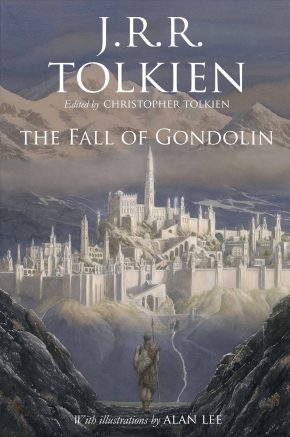 Today marks the publication of The Fall of Gondolin, the last of the three ‘Great Tales’ of the Elder Days to be published as a standalone book.
Today marks the publication of The Fall of Gondolin, the last of the three ‘Great Tales’ of the Elder Days to be published as a standalone book.
Edited by Christopher Tolkien and illustrated by Alan Lee, The Fall of Gondolin follows the same format as Beren and Lúthien published last year, separating out the story so that it stands alone while showing how the narrative evolved over the years. This is the first time the tale of the Fall of Gondolin has been published as a standalone edition, collecting all versions of the story together.
In the preface, Christopher Tolkien states that The Fall of Gondolin is “indubitably” his last book as editor of his father’s writings.
Responding to HarperCollins’s announcement earlier this year, Tolkien Society chair, Shaun Gunner, said:
We never dared to dream that we would see this published. The Fall of Gondolin is, to many in the Tolkien community, the Holy Grail of Tolkien texts as one of Tolkien’s three Great Tales alongside The Children of Húrin and Beren and Lúthien. This beautiful story captures the rise and fall of a great Elven kingdom, taking place millennia before the events of The Lord of the Rings. This book brings all the existing work together in one place to present the story in full.
The Fall of Gondolin was the first of the tales of the First Age to be composed—the earliest text was probably written during Tolkien’s convalescence at Great Haywood, Staffordshire, early in 1917. This version is the only full account of the story and belongs with ‘the Book of Lost Tales’, the earliest phase of Tolkien’s mythology. A compressed version of the story was written between 1926 and 1930 to bring it into harmony with the now much changed ‘Silmarillion’. Much later, probably in 1951, Tolkien began work on an entirely refashioned account that comes to an abrupt end once Tuor reaches the hidden city of Gondolin. Christopher Tolkien described his father’s abandonment of this text as “one of the saddest facts in the whole history of incompletion” (The Book of Lost Tales Part Two, p. 203).
The Fall of Gondolin runs to 304 pages and was been published in hardback, deluxe hardback, large print and e-book. The book is being published in the USA by Houghton Mifflin Harcourt and in other languages by numerous Tolkien publishers worldwide.
From the publisher
In the Tale of The Fall of Gondolin are two of the greatest powers in the world. There is Morgoth of the uttermost evil, unseen in this story but ruling over a vast military power from his fortress of Angband. Deeply opposed to Morgoth is Ulmo, second in might only to Manwë, chief of the Valar: he is called the Lord of Waters, of all seas, lakes, and rivers under the sky. But he works in secret in Middle-earth to support the Noldor, the kindred of the Elves among whom were numbered Húrin and Túrin Turambar.
Central to this enmity of the gods is the city of Gondolin, beautiful but undiscoverable. It was built and peopled by Noldorin Elves who, when they dwelt in Valinor, the land of the gods, rebelled against their rule and fled to Middle-earth. Turgon King of Gondolin is hated and feared above all his enemies by Morgoth, who seeks in vain to discover the marvellously hidden city, while the gods in Valinor in heated debate largely refuse to intervene in support of Ulmo’s desires and designs.
Into this world comes Tuor, cousin of Túrin, the instrument of Ulmo’s designs. Guided unseen by him Tuor sets out from the land of his birth on the fearful journey to Gondolin, and in one of the most arresting moments in the history of Middle-earth the sea-god himself appears to him, rising out of the ocean in the midst of a storm. In Gondolin he becomes great; he is wedded to Idril, Turgon’s daughter, and their son is Eärendel, whose birth and profound importance in days to come is foreseen by Ulmo.
At last comes the terrible ending. Morgoth learns through an act of supreme treachery all that he needs to mount a devastating attack on the city, with Balrogs and dragons and numberless Orcs. After a minutely observed account of the fall of Gondolin, the tale ends with the escape of Tuor and Idril, with the child Eärendel, looking back from a cleft in the mountains as they flee southward, at the blazing wreckage of their city. They were journeying into a new story, the Tale of Eärendel, which Tolkien never wrote, but which is sketched out in this book from other sources.
Following his presentation of Beren and Lúthien Christopher Tolkien has used the same ‘history in sequence’ mode in the writing of this edition of The Fall of Gondolin. In the words of J.R.R. Tolkien, it was ‘the first real story of this imaginary world’ and, together with Beren and Lúthien and The Children of Húrin, he regarded it as one of the three ‘Great Tales’ of the Elder Days.